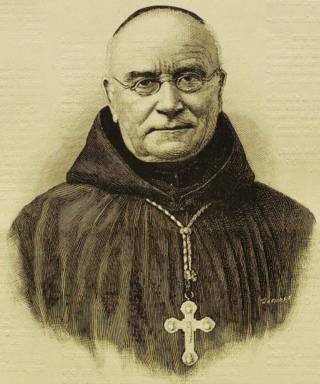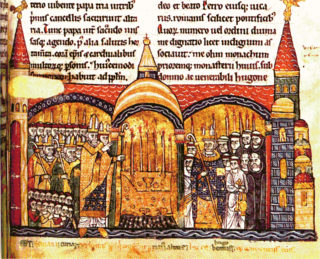
An abbey is a type of monastery used by members of a religious order under the governance of an abbot or abbess. Abbeys provide a complex of buildings and land for religious activities, work, and housing of Christian monks and nuns.

The Benedictines, officially the Order of Saint Benedict, are a mainly contemplative monastic religious order of the Catholic Church for men and for women who follow the Rule of Saint Benedict. The male religious are also sometimes called the Black Monks, in reference to the colour of their religious habits, pace the Olivetans who wear white. They were founded in 529 by Benedict of Nursia, a 6th-century Italian monk who laid the foundations of Benedictine monasticism through the formulation of his Rule. Benedict's sister, Scholastica, possibly his twin, also became a religious from an early age, but chose to live as a hermit. They retained a close relationship until her death.

Downside Abbey is a Benedictine monastery in England and the senior community of the English Benedictine Congregation. Until 2019, the community had close links with Downside School, for the education of children aged eleven to eighteen. Both the abbey and the school are at Stratton-on-the-Fosse, between Westfield and Shepton Mallet in Somerset, South West England. In 2020, the monastic community announced that it would move away from the present monastery and seek a new place to live. In October 2021, the monastic community further announced that as part of their transition they would move in Spring of 2022 to the temporary accommodation of "Southgate House, in the grounds of Buckfast Abbey, Devon, where we will live as the Community of St Gregory the Great". As of 2020, the monastic community of Downside Abbey was home to fifteen monks.

Cluny Abbey is a former Benedictine monastery in Cluny, Saône-et-Loire, France. It was dedicated to Saint Peter.

The Abbey of Our Lady, Help of Christians, commonly known as Worth Abbey, is a community of Roman Catholic monks who follow the Rule of St Benedict near Turners Hill village, in West Sussex, England. Founded in 1933, the abbey is part of the English Benedictine Congregation. As of 2020, the monastic community had 21 monks.

Henri Reynders (Dom Bruno) (24 October 1903 – 26 October 1981) was a Belgian priest credited with saving 400 Jews during the Holocaust.

Lambert Beauduin OSB was a Belgian monk who founded the monastery now known as Chevetogne Abbey in 1925. He was a leading member of the Belgian liturgical movement and a pioneer of the European liturgical revival.
Folkestone Priory was a pre-Reformation Benedictine monastery at Folkestone in the English county of Kent. The priory church survives as the present parish church. It was the successor to Folkestone Abbey, an Anglo-Saxon nunnery on a different site.

Ligugé Abbey, formally called the Abbey of St. Martin of Ligugé, is a French Benedictine monastery in the Commune of Ligugé, located in the Department of Vienne. Dating to the 4th century, it is the site of one of the earliest monastic foundations in France. The original abbey having been destroyed during the French Revolution, the current monastic community dates from 1853, and belongs to the Solesmes Congregation.
Lev Gillet was an archimandrite of the Eastern Orthodox Church. Brought up in the Roman Catholic tradition, he joined the Orthodox Church in 1928 and worked for the union of the churches.

Prosper Louis Pascal Guéranger was a French priest and Benedictine monk, who served for nearly 40 years as the abbot of the monastery of Solesmes. Through the new Abbey of Solesmes he became the founder of the French Benedictine Congregation, which re-established Benedictine monastic life in France after it had been wiped out by the French Revolution. Guéranger was the author of The Liturgical Year, a popular commentary which covers every day of the Catholic Church's Liturgical cycles in 15 volumes. He was well regarded by Pope Pius IX, and was a proponent of the dogmas of the Immaculate Conception and of papal infallibility.
Westmalle Abbey, otherwise the Trappist Abbey of Westmalle, is a monastery of the Cistercians of Strict Observance in Westmalle in the Belgian province of Antwerp.
Paul Irénée Couturier was a French priest and a promoter of the concept of Christian unity. He was instrumental in the establishment of the Week of Prayer for Christian Unity.

Keizersberg Abbey, also known as Mont César Abbey is a Benedictine monastery on the hill Keizersberg or Mont César in the north of the university town of Leuven, Belgium.

Louis-Charles Couturier, O.S.B., was a French Benedictine monk, Abbot of the Abbey of Saint-Pierre at Solesmes and President of the French Congregation of the Order of St. Benedict.

By the 10th century, Christianity had spread throughout much of Europe and Asia. The Church in England was becoming well established, with its scholarly monasteries, and the Roman Church and the Eastern Orthodox Church were continuing their separation, ultimately culminating in the Great Schism.
St. Andrew's Abbey, Bruges was a Benedictine abbey in Sint-Andries, Bruges, Belgium, which was destroyed in the French Revolution. Its modern successor St. Andrew's Abbey, Zevenkerken, founded in 1899–1900, is a Benedictine abbey of the Congregation of the Annunciation.
The Pontifical Greek College of St. Athanasius is a Pontifical College in Rome that observes the Byzantine rite.

Dom Gaspar Lefebvre was a French churchman. A Benedictine monk, he wrote about the Catholic liturgy.


















